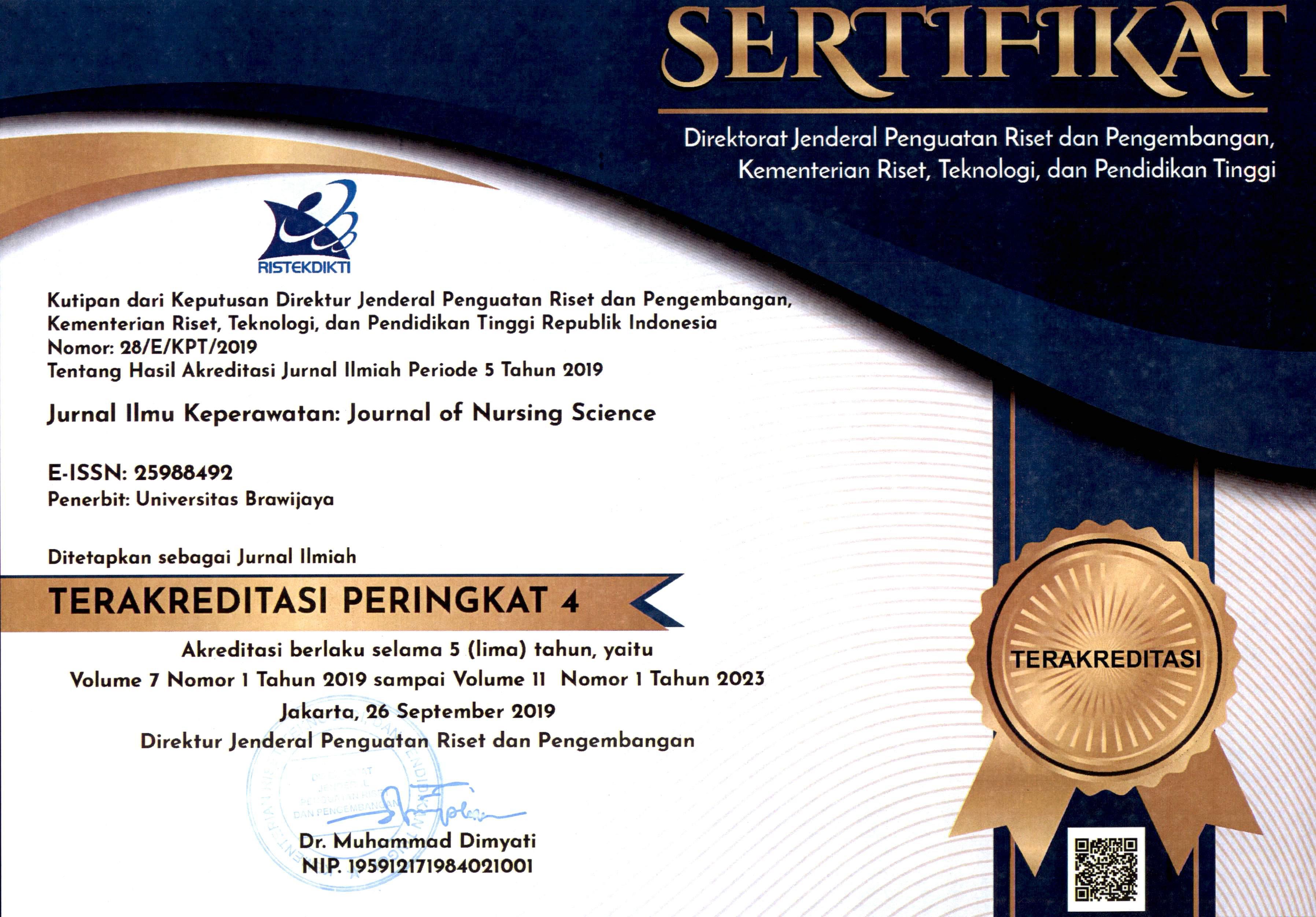Clinical Learning Environment in Hospitals: Assessment of Nursing Students
DOI:
https://doi.org/10.21776/ub.jik.2021.009.01.6Keywords:
Clinical learning environment, Nursing student, SatisfactionAbstract
Evaluation of the clinical learning environment is essential because it can improve the success of students undergoing clinical practice in hospitals. With this evaluation, the clinical learning environment will be better and have an impact on nursing institutions that can prepare good quality graduate students. This study aimed to evaluate the clinical learning environment of nursing profession students in hospitals. The research design used descriptive and involved 229 professional nursing students consisting of 23 and 24 batches of Nursing at the University of Jember, which were collected by using total sampling. The results of the evaluation of the clinical learning environment of professional nurses in hospitals showed an average score of 132.7 from the maximum score 170. Every indicator has an average value and the percentage of achievement starting from the highest to the lowest; the relationship of supervision (clinical supervisor or clinical instructor) with an average of 31.10 (77.75%), leadership style of the inpatient ward manajer with an average of 15, 41 (77.05%), the role of nurse lecturers (academic lecturers) with an average of 34.02 (75.60%), nursing service places with an average of 15.05 (75.25%) and an atmosphere of learning strategies with an average of 33.25 (73.25) and overall student satisfaction obtained an average value of 3.92 (78.40%). The results of the study show that nursing students is still not fully satisfied toward clinical learning environment. It must be improved to provide a suitable clinical learning environment so that students feel satisfied and clinical competence can be achieved.
References
- Adila, W. (2015). Peran Pembimbing Praktik Klinik Pada Praktik Klinik Keperawatan Diploma III Keperawatan Stikes An-Nur Purwodadi. Kebidanan, 15(2), 1–8.
- AIPNI. (2014). Materi Pelatihan Preceptorship. Stikes Alma Ata.
- Astuti, I. M. (2010). Pembelajaran Praktik Klinik Keperawatan Mahasiswa Tingkat II Akademi Keperawatan Kosgoro Mojokerto Di Rumah Sakit Tipe A. Universitas Sebelah Maret Surakarta.
- Azizah, L. K., & Ropyanto, C. B. (2012). Tingkat Kepuasan Bimbingan Klinik Mahasiswa Keperawatan. Jurnal Nursing Studies, 1(1), 219–224.
- Ekstedt, M., Lindblad, M., & Lofmark, A. (2019). Nursing students’ perception of the clinical learning environment and supervision in relation to two different supervision models – a comparative cross-sectional study. BMC Nursing, 18(1), 1–12. https://doi.org/10.1186/s12912-019-0375-6
- Heriyanto. (2017). Pengaruh Pelayanan dan Fasilitas terhadap Kepuasan Mahasiswa Sekolah Tinggi Agama Buddha Negeri Sriwijaya Tangerang Banten. Jurnal Vijjacariya, IV(1), 1–14.
- Layuk, Y. T., Harjanto, T., & Hapsari, E. D. (2016). Hubungan Persepsi Lingkungan Pembelajaran Klinik Dengan Perilaku Caring Pada Mahasiswa Profesi Ners. JPPNI, 1(2).
- Nahariani, P., Kurdi, F., & Priyanti, R. P. (2018). The Perception of Indonesian Nursing Students on the Learning Environment in Clinical Practice. Jurnal Ners, 13(2), 233. https://doi.org/10.20473/jn.v13i2.9770
- Nelwati, Putri, H. T., & Rahayungsih, A. (2012). Hubungan Lingkungan Belajar Klinik dengan Tingkat Kecemasan Mahasiswa pada Program Pendidikan Ners. NERS Jurnal Keperawatan, 8(1), 16. https://doi.org/10.25077/njk.8.1.16-23.2012
- Nurhidayah, R. (2011). Pendidikan Keperawatan Pendekatan Kurikulum Berbasis Kompetensi. USU Press.
- Nursalam. (2011). Manajemen Keperawatan Aplikasi Dalam Praktik Keperawatan Profesional (3rd ed.). Salemba Medika.
- Nursalam. (2012). Manajemen Keperawatan : Aplikasi Dalam Praktik Keperawatan Profesional. Salemba Medika.
- Nursalam, & Efendi, F. (2008). Pendidikan Dalam Keperawatan. Salemba Medika.
- Nursalam, & Efendi, F. (2012). Pendidikan Dalam Keperawatan. Salemba Medika.
- Papastavrou, E., Dimitriadou, M., Tsangari, H., & Andreou, C. (2016a). Nursing students’ satisfaction of the clinical learning environment: A research study. BMC Nursing, 15(1), 1–10. https://doi.org/10.1186/s12912-016-0164-4
- Priyanti, R. P., & Nahariani, P. (2016). Skala Evaluasi Lingkungan Belajar Klinik, Supervisi Dan Dosen Perawat (Clinical Learning Environment, Supervision And Nurse Teacher – Cles+T) Versi Bahasa Indonesia: Validitas Dan Reliabilitas. Jurnal Ilmah Kesehatan, 9(2), 107–113. https://doi.org/10.33086/jhs.v9i2.156
- Putri, T. (2012). Hubungan Lingkungan Belajar Klinik Dengan Tingkat Kecemasan Pada Pembelajaran Klinik Program Ners PSIK FK Universitas Andalas Padang.
- Sercekus, P., & Baskale, H. (2016). Nursing Students Perceptions about Clinical Learning Environment in Turkey. Nurse Education Practice.
- Wijaya, A. (2012). Solusi Tata Kelola Praktik Klinik Di Rumah Sakit. Medianers.
Downloads
Published
How to Cite
License
Authors published in this journal agree to the following terms:
1. The copyright of the received article shall be assigned to the journal as the publisher of the journal. The intended copyright includes the right to publish the article in various forms (including reprints). The journal maintains the publishing rights to the published articles.
2. Authors may enter into separate additional contractual agreements for the non-exclusive distribution of the published journal version of the work (for example, posting it to an institutional repository or publishing it in a book), with acknowledgment of their initial publication in this journal.
3. Authors are permitted and encouraged to post their work online (e.g. in an Institutional Repository or on their website) before and during the submission process, as this can result in a productive exchange, as well as earlier and larger citations of the published work.
4. Articles and all related material published are distributed under Creative Commons Attribution-NonCommercial 4.0 International License or CC BY-NC 4.0 license.
JNSU is licensed under a Creative Commons Attribution-NonCommercial 4.0 International License or CC BY-NC 4.0 license.
Most read articles by the same author(s)
- Dicky Endrian Kurniawan, Dewi Kartikawati Ningsih, NEBULIZATION INTERVENTION OF ACUTE ASTHMA EXACERBATION IN EMERGENCY DEPARTMENT : A LITERATURE REVIEW , Journal of Nursing Science Update (JNSU): Vol. 5 No. 2 (2017)
- Dian Indah Lestari, Retno Purwandari, Alfid Tri Afandi, Description of Musculoskeletal Disorders and Work Position in Citrus Farmers at Sukoreno Village, Umbulsari District, Jember , Journal of Nursing Science Update (JNSU): Vol. 9 No. 1 (2021)






























